Analysis of Business Environment Factors: Ripley Electronics Essay
VerifiedAdded on 2020/01/28
|10
|4627
|298
Essay
AI Summary
This essay provides a comprehensive analysis of the business environment, focusing on Ripley Electronics (RE), a UK-based computer parts manufacturer. It explores organizational structures, distinguishing between private, public, and non-profit sectors, and examines the objectives of various stakeholders, including owners, customers, employees, suppliers, trade unions, and the government. The essay also delves into RE's responsibilities and strategies for meeting stakeholder expectations, emphasizing the importance of Corporate Social Responsibility (CSR). Furthermore, it analyzes the allocation and effective utilization of resources within economic systems, specifically the impact of fiscal and monetary policies on RE's activities. The essay also assesses the effects of competition policy and regulatory mechanisms, such as the Computer Misuse Act 1990. Finally, it examines how market structures, including perfect competition, monopoly, monopolistic competition, and oligopoly, influence pricing and output decisions within the business environment.
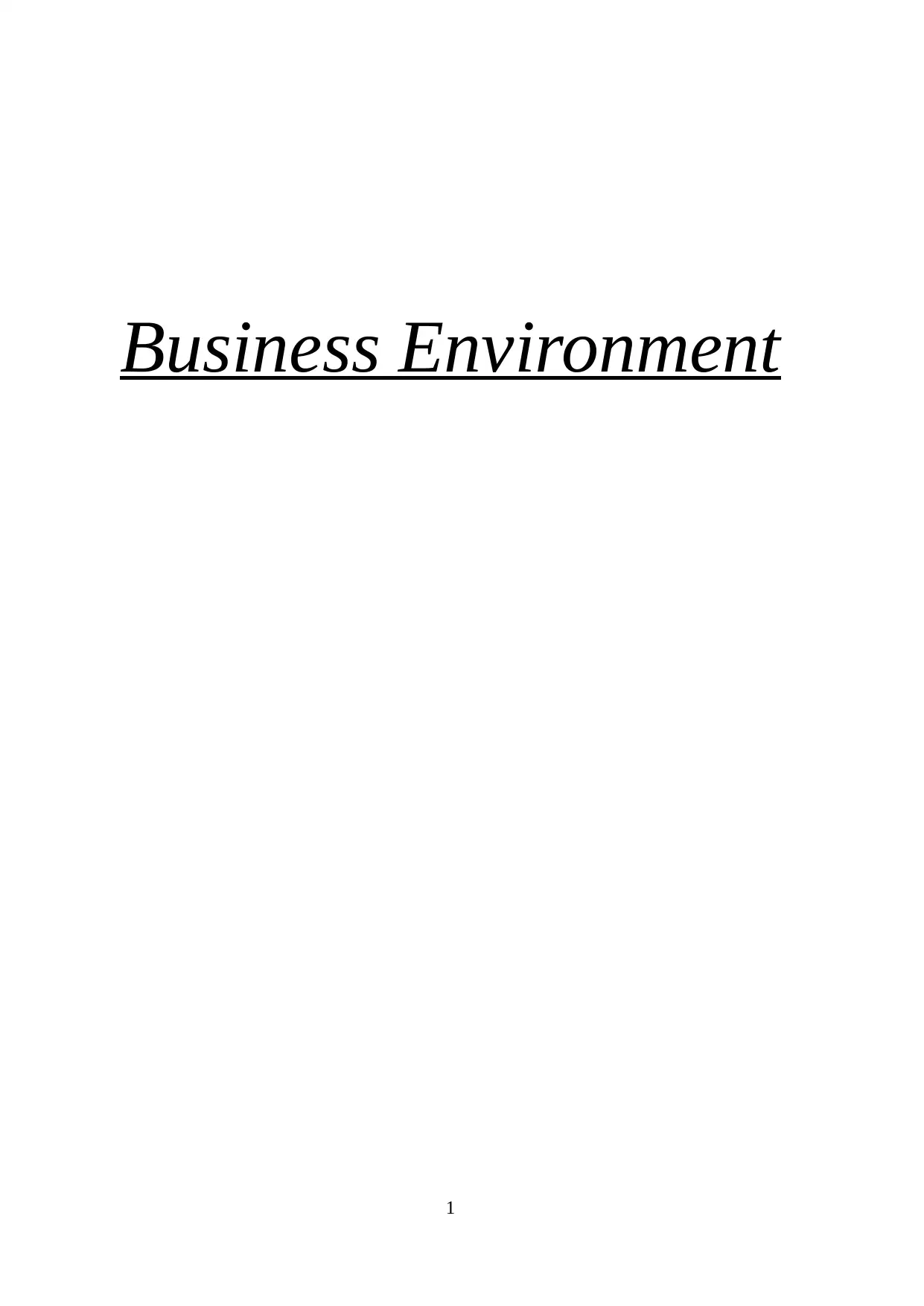
Business Environment
1
1
Paraphrase This Document
Need a fresh take? Get an instant paraphrase of this document with our AI Paraphraser
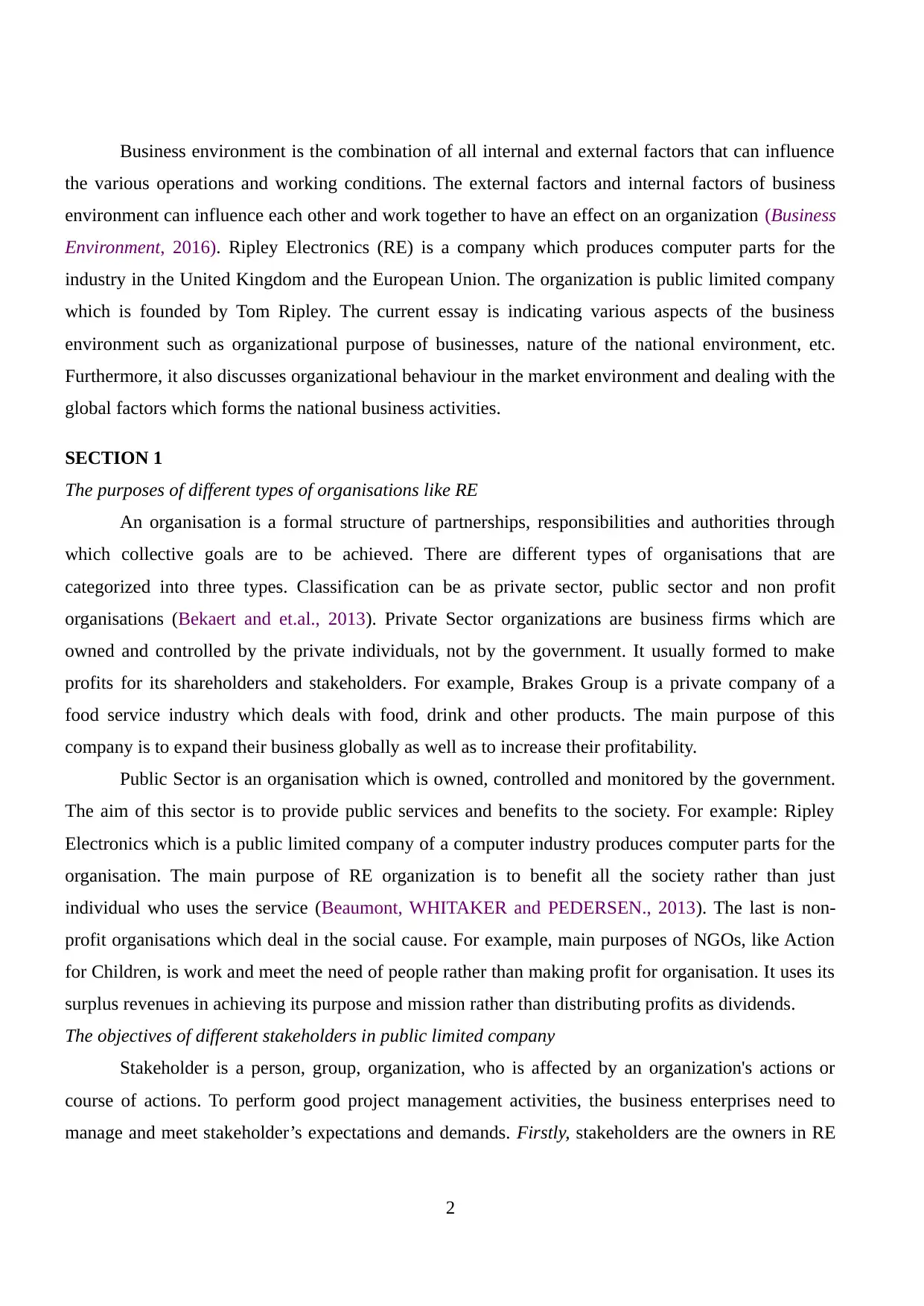
Business environment is the combination of all internal and external factors that can influence
the various operations and working conditions. The external factors and internal factors of business
environment can influence each other and work together to have an effect on an organization (Business
Environment, 2016). Ripley Electronics (RE) is a company which produces computer parts for the
industry in the United Kingdom and the European Union. The organization is public limited company
which is founded by Tom Ripley. The current essay is indicating various aspects of the business
environment such as organizational purpose of businesses, nature of the national environment, etc.
Furthermore, it also discusses organizational behaviour in the market environment and dealing with the
global factors which forms the national business activities.
SECTION 1
The purposes of different types of organisations like RE
An organisation is a formal structure of partnerships, responsibilities and authorities through
which collective goals are to be achieved. There are different types of organisations that are
categorized into three types. Classification can be as private sector, public sector and non profit
organisations (Bekaert and et.al., 2013). Private Sector organizations are business firms which are
owned and controlled by the private individuals, not by the government. It usually formed to make
profits for its shareholders and stakeholders. For example, Brakes Group is a private company of a
food service industry which deals with food, drink and other products. The main purpose of this
company is to expand their business globally as well as to increase their profitability.
Public Sector is an organisation which is owned, controlled and monitored by the government.
The aim of this sector is to provide public services and benefits to the society. For example: Ripley
Electronics which is a public limited company of a computer industry produces computer parts for the
organisation. The main purpose of RE organization is to benefit all the society rather than just
individual who uses the service (Beaumont, WHITAKER and PEDERSEN., 2013). The last is non-
profit organisations which deal in the social cause. For example, main purposes of NGOs, like Action
for Children, is work and meet the need of people rather than making profit for organisation. It uses its
surplus revenues in achieving its purpose and mission rather than distributing profits as dividends.
The objectives of different stakeholders in public limited company
Stakeholder is a person, group, organization, who is affected by an organization's actions or
course of actions. To perform good project management activities, the business enterprises need to
manage and meet stakeholder’s expectations and demands. Firstly, stakeholders are the owners in RE
2
the various operations and working conditions. The external factors and internal factors of business
environment can influence each other and work together to have an effect on an organization (Business
Environment, 2016). Ripley Electronics (RE) is a company which produces computer parts for the
industry in the United Kingdom and the European Union. The organization is public limited company
which is founded by Tom Ripley. The current essay is indicating various aspects of the business
environment such as organizational purpose of businesses, nature of the national environment, etc.
Furthermore, it also discusses organizational behaviour in the market environment and dealing with the
global factors which forms the national business activities.
SECTION 1
The purposes of different types of organisations like RE
An organisation is a formal structure of partnerships, responsibilities and authorities through
which collective goals are to be achieved. There are different types of organisations that are
categorized into three types. Classification can be as private sector, public sector and non profit
organisations (Bekaert and et.al., 2013). Private Sector organizations are business firms which are
owned and controlled by the private individuals, not by the government. It usually formed to make
profits for its shareholders and stakeholders. For example, Brakes Group is a private company of a
food service industry which deals with food, drink and other products. The main purpose of this
company is to expand their business globally as well as to increase their profitability.
Public Sector is an organisation which is owned, controlled and monitored by the government.
The aim of this sector is to provide public services and benefits to the society. For example: Ripley
Electronics which is a public limited company of a computer industry produces computer parts for the
organisation. The main purpose of RE organization is to benefit all the society rather than just
individual who uses the service (Beaumont, WHITAKER and PEDERSEN., 2013). The last is non-
profit organisations which deal in the social cause. For example, main purposes of NGOs, like Action
for Children, is work and meet the need of people rather than making profit for organisation. It uses its
surplus revenues in achieving its purpose and mission rather than distributing profits as dividends.
The objectives of different stakeholders in public limited company
Stakeholder is a person, group, organization, who is affected by an organization's actions or
course of actions. To perform good project management activities, the business enterprises need to
manage and meet stakeholder’s expectations and demands. Firstly, stakeholders are the owners in RE
2
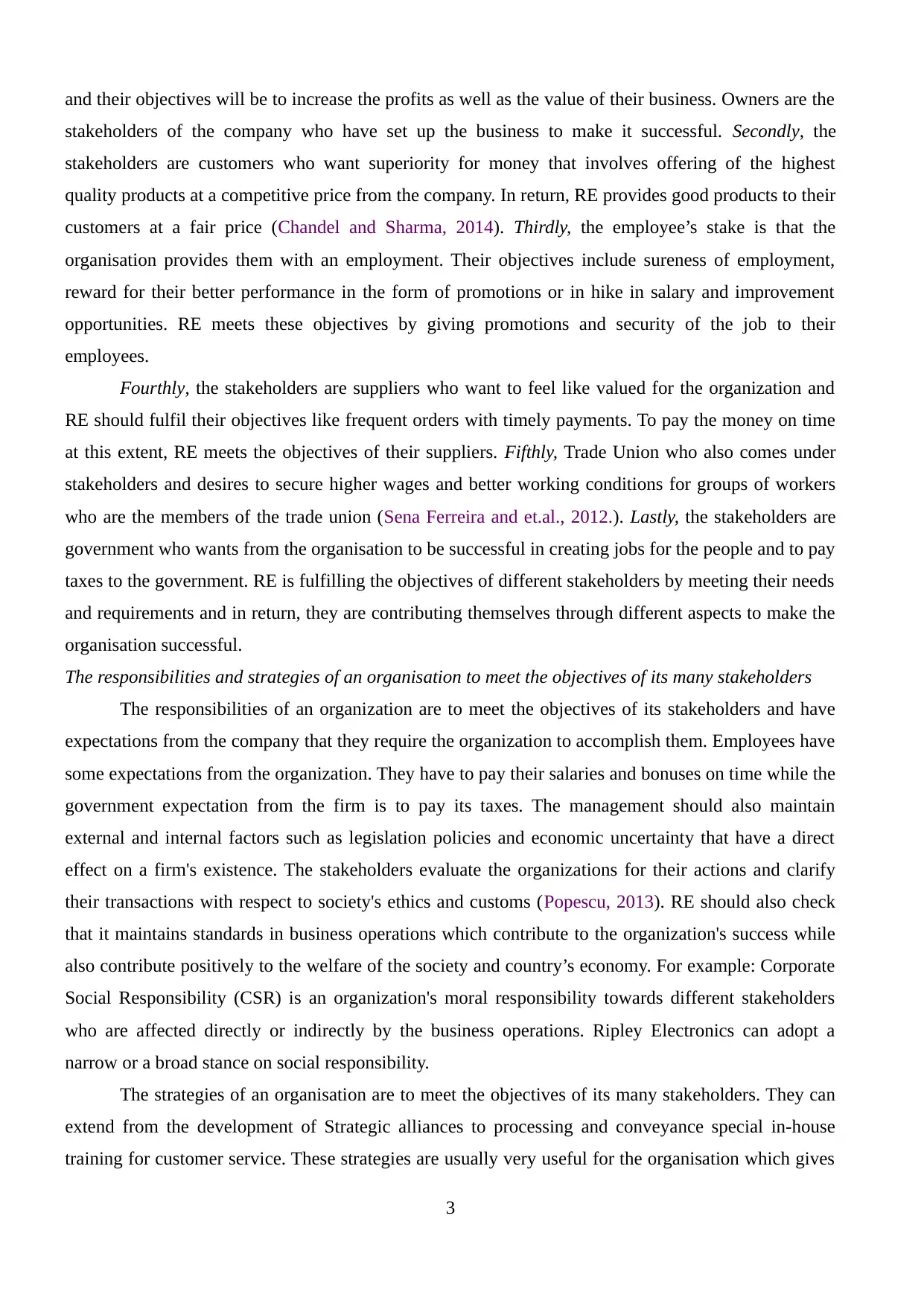
and their objectives will be to increase the profits as well as the value of their business. Owners are the
stakeholders of the company who have set up the business to make it successful. Secondly, the
stakeholders are customers who want superiority for money that involves offering of the highest
quality products at a competitive price from the company. In return, RE provides good products to their
customers at a fair price (Chandel and Sharma, 2014). Thirdly, the employee’s stake is that the
organisation provides them with an employment. Their objectives include sureness of employment,
reward for their better performance in the form of promotions or in hike in salary and improvement
opportunities. RE meets these objectives by giving promotions and security of the job to their
employees.
Fourthly, the stakeholders are suppliers who want to feel like valued for the organization and
RE should fulfil their objectives like frequent orders with timely payments. To pay the money on time
at this extent, RE meets the objectives of their suppliers. Fifthly, Trade Union who also comes under
stakeholders and desires to secure higher wages and better working conditions for groups of workers
who are the members of the trade union (Sena Ferreira and et.al., 2012.). Lastly, the stakeholders are
government who wants from the organisation to be successful in creating jobs for the people and to pay
taxes to the government. RE is fulfilling the objectives of different stakeholders by meeting their needs
and requirements and in return, they are contributing themselves through different aspects to make the
organisation successful.
The responsibilities and strategies of an organisation to meet the objectives of its many stakeholders
The responsibilities of an organization are to meet the objectives of its stakeholders and have
expectations from the company that they require the organization to accomplish them. Employees have
some expectations from the organization. They have to pay their salaries and bonuses on time while the
government expectation from the firm is to pay its taxes. The management should also maintain
external and internal factors such as legislation policies and economic uncertainty that have a direct
effect on a firm's existence. The stakeholders evaluate the organizations for their actions and clarify
their transactions with respect to society's ethics and customs (Popescu, 2013). RE should also check
that it maintains standards in business operations which contribute to the organization's success while
also contribute positively to the welfare of the society and country’s economy. For example: Corporate
Social Responsibility (CSR) is an organization's moral responsibility towards different stakeholders
who are affected directly or indirectly by the business operations. Ripley Electronics can adopt a
narrow or a broad stance on social responsibility.
The strategies of an organisation are to meet the objectives of its many stakeholders. They can
extend from the development of Strategic alliances to processing and conveyance special in-house
training for customer service. These strategies are usually very useful for the organisation which gives
3
stakeholders of the company who have set up the business to make it successful. Secondly, the
stakeholders are customers who want superiority for money that involves offering of the highest
quality products at a competitive price from the company. In return, RE provides good products to their
customers at a fair price (Chandel and Sharma, 2014). Thirdly, the employee’s stake is that the
organisation provides them with an employment. Their objectives include sureness of employment,
reward for their better performance in the form of promotions or in hike in salary and improvement
opportunities. RE meets these objectives by giving promotions and security of the job to their
employees.
Fourthly, the stakeholders are suppliers who want to feel like valued for the organization and
RE should fulfil their objectives like frequent orders with timely payments. To pay the money on time
at this extent, RE meets the objectives of their suppliers. Fifthly, Trade Union who also comes under
stakeholders and desires to secure higher wages and better working conditions for groups of workers
who are the members of the trade union (Sena Ferreira and et.al., 2012.). Lastly, the stakeholders are
government who wants from the organisation to be successful in creating jobs for the people and to pay
taxes to the government. RE is fulfilling the objectives of different stakeholders by meeting their needs
and requirements and in return, they are contributing themselves through different aspects to make the
organisation successful.
The responsibilities and strategies of an organisation to meet the objectives of its many stakeholders
The responsibilities of an organization are to meet the objectives of its stakeholders and have
expectations from the company that they require the organization to accomplish them. Employees have
some expectations from the organization. They have to pay their salaries and bonuses on time while the
government expectation from the firm is to pay its taxes. The management should also maintain
external and internal factors such as legislation policies and economic uncertainty that have a direct
effect on a firm's existence. The stakeholders evaluate the organizations for their actions and clarify
their transactions with respect to society's ethics and customs (Popescu, 2013). RE should also check
that it maintains standards in business operations which contribute to the organization's success while
also contribute positively to the welfare of the society and country’s economy. For example: Corporate
Social Responsibility (CSR) is an organization's moral responsibility towards different stakeholders
who are affected directly or indirectly by the business operations. Ripley Electronics can adopt a
narrow or a broad stance on social responsibility.
The strategies of an organisation are to meet the objectives of its many stakeholders. They can
extend from the development of Strategic alliances to processing and conveyance special in-house
training for customer service. These strategies are usually very useful for the organisation which gives
3
⊘ This is a preview!⊘
Do you want full access?
Subscribe today to unlock all pages.

Trusted by 1+ million students worldwide
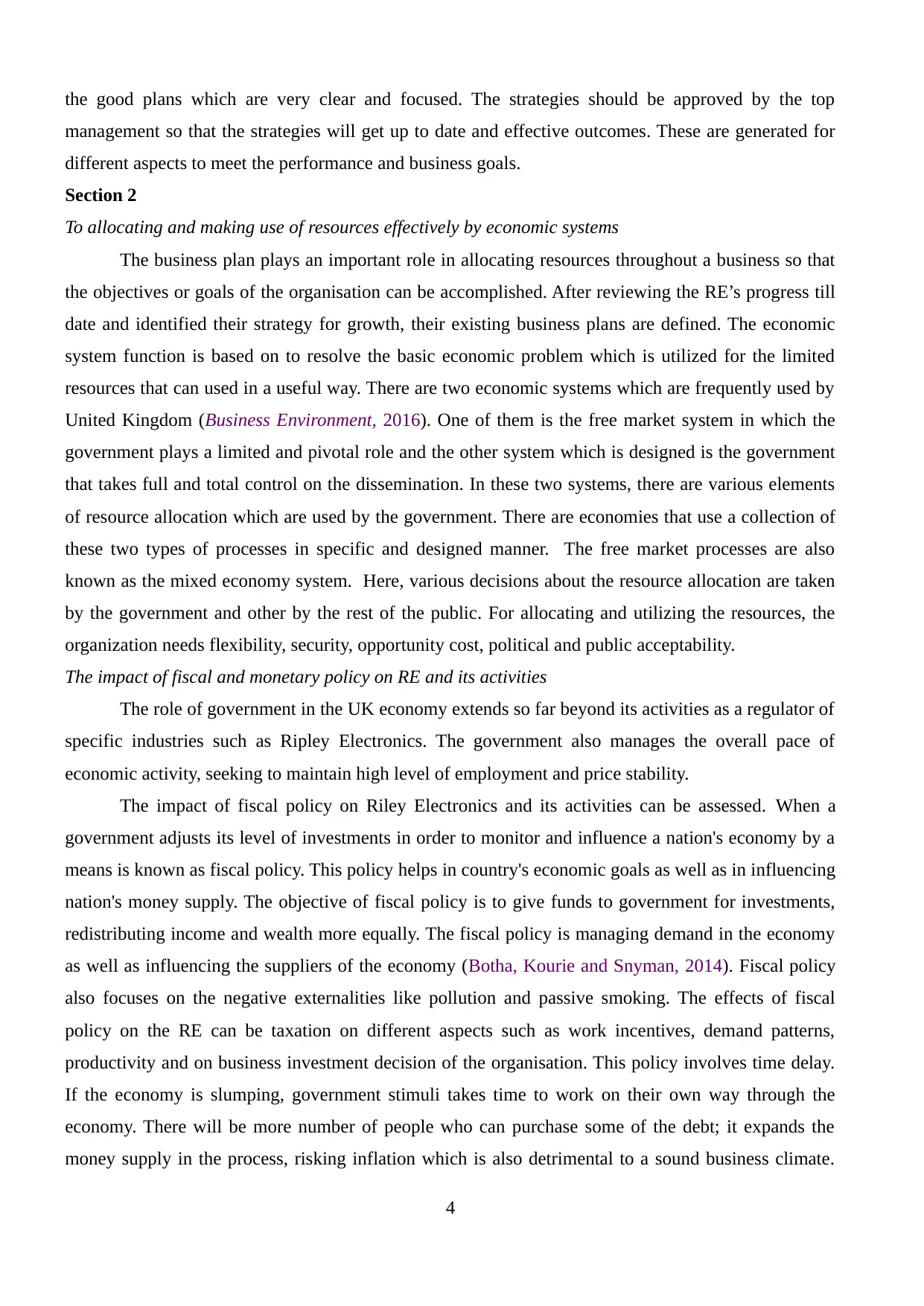
the good plans which are very clear and focused. The strategies should be approved by the top
management so that the strategies will get up to date and effective outcomes. These are generated for
different aspects to meet the performance and business goals.
Section 2
To allocating and making use of resources effectively by economic systems
The business plan plays an important role in allocating resources throughout a business so that
the objectives or goals of the organisation can be accomplished. After reviewing the RE’s progress till
date and identified their strategy for growth, their existing business plans are defined. The economic
system function is based on to resolve the basic economic problem which is utilized for the limited
resources that can used in a useful way. There are two economic systems which are frequently used by
United Kingdom (Business Environment, 2016). One of them is the free market system in which the
government plays a limited and pivotal role and the other system which is designed is the government
that takes full and total control on the dissemination. In these two systems, there are various elements
of resource allocation which are used by the government. There are economies that use a collection of
these two types of processes in specific and designed manner. The free market processes are also
known as the mixed economy system. Here, various decisions about the resource allocation are taken
by the government and other by the rest of the public. For allocating and utilizing the resources, the
organization needs flexibility, security, opportunity cost, political and public acceptability.
The impact of fiscal and monetary policy on RE and its activities
The role of government in the UK economy extends so far beyond its activities as a regulator of
specific industries such as Ripley Electronics. The government also manages the overall pace of
economic activity, seeking to maintain high level of employment and price stability.
The impact of fiscal policy on Riley Electronics and its activities can be assessed. When a
government adjusts its level of investments in order to monitor and influence a nation's economy by a
means is known as fiscal policy. This policy helps in country's economic goals as well as in influencing
nation's money supply. The objective of fiscal policy is to give funds to government for investments,
redistributing income and wealth more equally. The fiscal policy is managing demand in the economy
as well as influencing the suppliers of the economy (Botha, Kourie and Snyman, 2014). Fiscal policy
also focuses on the negative externalities like pollution and passive smoking. The effects of fiscal
policy on the RE can be taxation on different aspects such as work incentives, demand patterns,
productivity and on business investment decision of the organisation. This policy involves time delay.
If the economy is slumping, government stimuli takes time to work on their own way through the
economy. There will be more number of people who can purchase some of the debt; it expands the
money supply in the process, risking inflation which is also detrimental to a sound business climate.
4
management so that the strategies will get up to date and effective outcomes. These are generated for
different aspects to meet the performance and business goals.
Section 2
To allocating and making use of resources effectively by economic systems
The business plan plays an important role in allocating resources throughout a business so that
the objectives or goals of the organisation can be accomplished. After reviewing the RE’s progress till
date and identified their strategy for growth, their existing business plans are defined. The economic
system function is based on to resolve the basic economic problem which is utilized for the limited
resources that can used in a useful way. There are two economic systems which are frequently used by
United Kingdom (Business Environment, 2016). One of them is the free market system in which the
government plays a limited and pivotal role and the other system which is designed is the government
that takes full and total control on the dissemination. In these two systems, there are various elements
of resource allocation which are used by the government. There are economies that use a collection of
these two types of processes in specific and designed manner. The free market processes are also
known as the mixed economy system. Here, various decisions about the resource allocation are taken
by the government and other by the rest of the public. For allocating and utilizing the resources, the
organization needs flexibility, security, opportunity cost, political and public acceptability.
The impact of fiscal and monetary policy on RE and its activities
The role of government in the UK economy extends so far beyond its activities as a regulator of
specific industries such as Ripley Electronics. The government also manages the overall pace of
economic activity, seeking to maintain high level of employment and price stability.
The impact of fiscal policy on Riley Electronics and its activities can be assessed. When a
government adjusts its level of investments in order to monitor and influence a nation's economy by a
means is known as fiscal policy. This policy helps in country's economic goals as well as in influencing
nation's money supply. The objective of fiscal policy is to give funds to government for investments,
redistributing income and wealth more equally. The fiscal policy is managing demand in the economy
as well as influencing the suppliers of the economy (Botha, Kourie and Snyman, 2014). Fiscal policy
also focuses on the negative externalities like pollution and passive smoking. The effects of fiscal
policy on the RE can be taxation on different aspects such as work incentives, demand patterns,
productivity and on business investment decision of the organisation. This policy involves time delay.
If the economy is slumping, government stimuli takes time to work on their own way through the
economy. There will be more number of people who can purchase some of the debt; it expands the
money supply in the process, risking inflation which is also detrimental to a sound business climate.
4
Paraphrase This Document
Need a fresh take? Get an instant paraphrase of this document with our AI Paraphraser
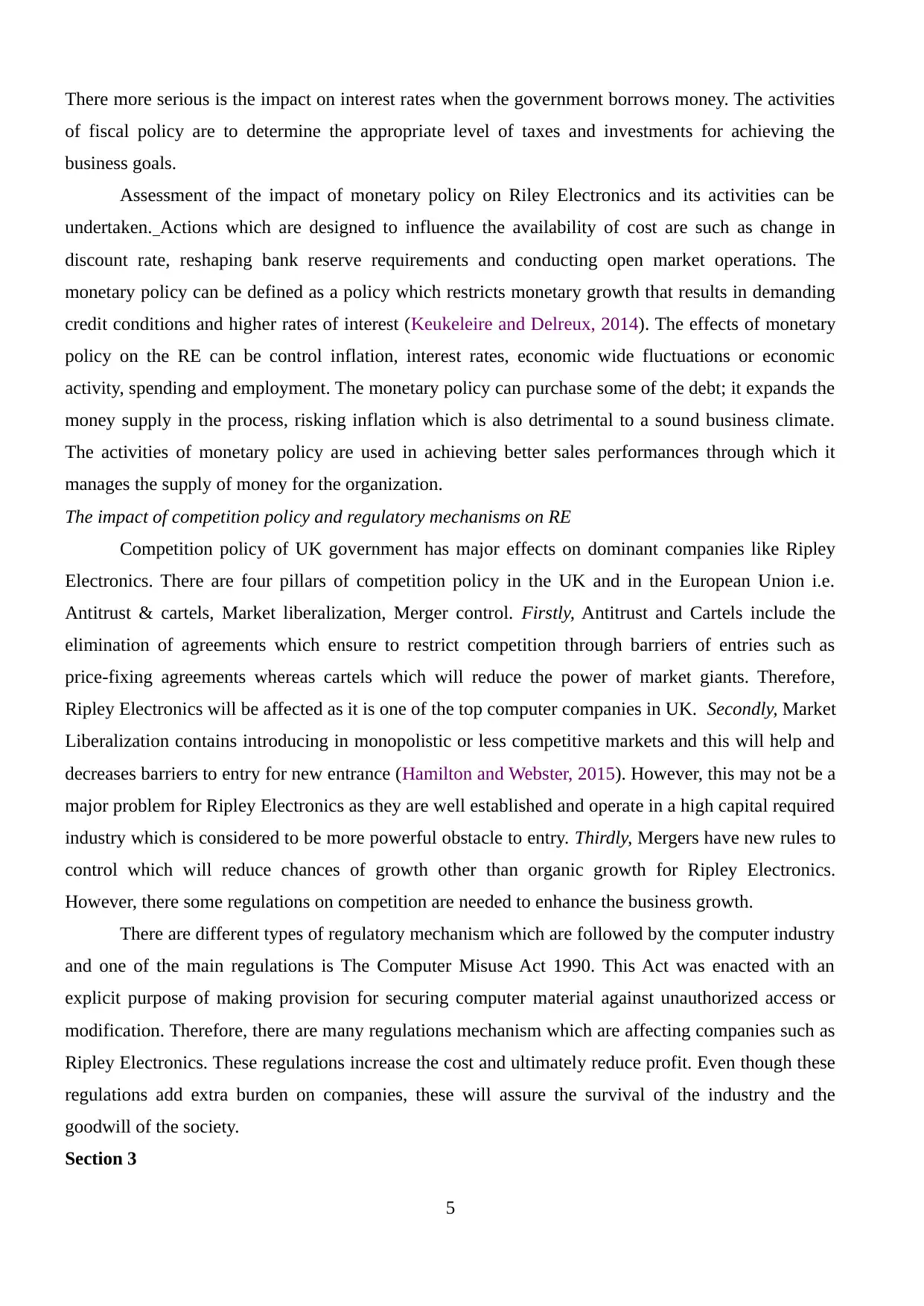
There more serious is the impact on interest rates when the government borrows money. The activities
of fiscal policy are to determine the appropriate level of taxes and investments for achieving the
business goals.
Assessment of the impact of monetary policy on Riley Electronics and its activities can be
undertaken. Actions which are designed to influence the availability of cost are such as change in
discount rate, reshaping bank reserve requirements and conducting open market operations. The
monetary policy can be defined as a policy which restricts monetary growth that results in demanding
credit conditions and higher rates of interest (Keukeleire and Delreux, 2014). The effects of monetary
policy on the RE can be control inflation, interest rates, economic wide fluctuations or economic
activity, spending and employment. The monetary policy can purchase some of the debt; it expands the
money supply in the process, risking inflation which is also detrimental to a sound business climate.
The activities of monetary policy are used in achieving better sales performances through which it
manages the supply of money for the organization.
The impact of competition policy and regulatory mechanisms on RE
Competition policy of UK government has major effects on dominant companies like Ripley
Electronics. There are four pillars of competition policy in the UK and in the European Union i.e.
Antitrust & cartels, Market liberalization, Merger control. Firstly, Antitrust and Cartels include the
elimination of agreements which ensure to restrict competition through barriers of entries such as
price-fixing agreements whereas cartels which will reduce the power of market giants. Therefore,
Ripley Electronics will be affected as it is one of the top computer companies in UK. Secondly, Market
Liberalization contains introducing in monopolistic or less competitive markets and this will help and
decreases barriers to entry for new entrance (Hamilton and Webster, 2015). However, this may not be a
major problem for Ripley Electronics as they are well established and operate in a high capital required
industry which is considered to be more powerful obstacle to entry. Thirdly, Mergers have new rules to
control which will reduce chances of growth other than organic growth for Ripley Electronics.
However, there some regulations on competition are needed to enhance the business growth.
There are different types of regulatory mechanism which are followed by the computer industry
and one of the main regulations is The Computer Misuse Act 1990. This Act was enacted with an
explicit purpose of making provision for securing computer material against unauthorized access or
modification. Therefore, there are many regulations mechanism which are affecting companies such as
Ripley Electronics. These regulations increase the cost and ultimately reduce profit. Even though these
regulations add extra burden on companies, these will assure the survival of the industry and the
goodwill of the society.
Section 3
5
of fiscal policy are to determine the appropriate level of taxes and investments for achieving the
business goals.
Assessment of the impact of monetary policy on Riley Electronics and its activities can be
undertaken. Actions which are designed to influence the availability of cost are such as change in
discount rate, reshaping bank reserve requirements and conducting open market operations. The
monetary policy can be defined as a policy which restricts monetary growth that results in demanding
credit conditions and higher rates of interest (Keukeleire and Delreux, 2014). The effects of monetary
policy on the RE can be control inflation, interest rates, economic wide fluctuations or economic
activity, spending and employment. The monetary policy can purchase some of the debt; it expands the
money supply in the process, risking inflation which is also detrimental to a sound business climate.
The activities of monetary policy are used in achieving better sales performances through which it
manages the supply of money for the organization.
The impact of competition policy and regulatory mechanisms on RE
Competition policy of UK government has major effects on dominant companies like Ripley
Electronics. There are four pillars of competition policy in the UK and in the European Union i.e.
Antitrust & cartels, Market liberalization, Merger control. Firstly, Antitrust and Cartels include the
elimination of agreements which ensure to restrict competition through barriers of entries such as
price-fixing agreements whereas cartels which will reduce the power of market giants. Therefore,
Ripley Electronics will be affected as it is one of the top computer companies in UK. Secondly, Market
Liberalization contains introducing in monopolistic or less competitive markets and this will help and
decreases barriers to entry for new entrance (Hamilton and Webster, 2015). However, this may not be a
major problem for Ripley Electronics as they are well established and operate in a high capital required
industry which is considered to be more powerful obstacle to entry. Thirdly, Mergers have new rules to
control which will reduce chances of growth other than organic growth for Ripley Electronics.
However, there some regulations on competition are needed to enhance the business growth.
There are different types of regulatory mechanism which are followed by the computer industry
and one of the main regulations is The Computer Misuse Act 1990. This Act was enacted with an
explicit purpose of making provision for securing computer material against unauthorized access or
modification. Therefore, there are many regulations mechanism which are affecting companies such as
Ripley Electronics. These regulations increase the cost and ultimately reduce profit. Even though these
regulations add extra burden on companies, these will assure the survival of the industry and the
goodwill of the society.
Section 3
5
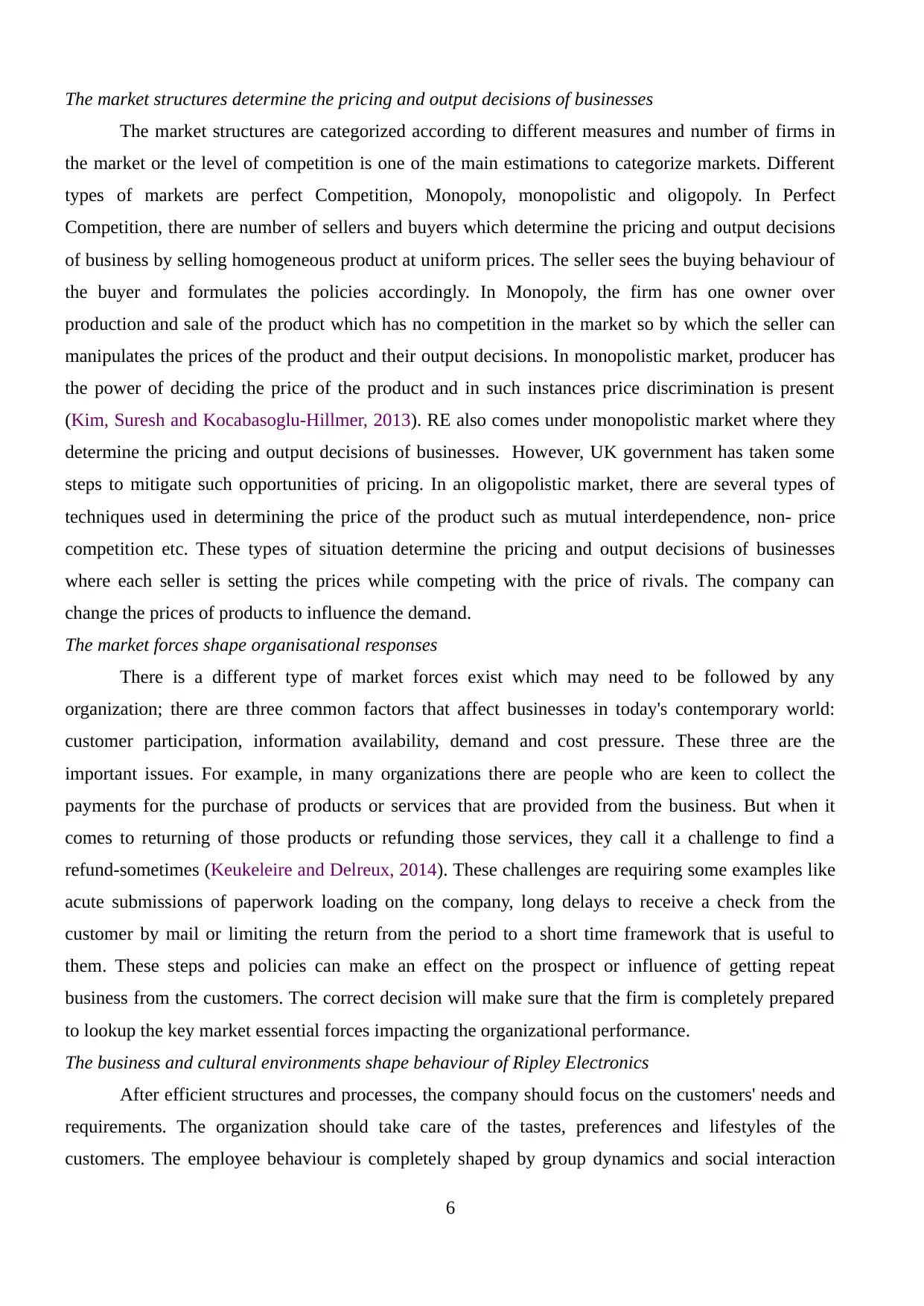
The market structures determine the pricing and output decisions of businesses
The market structures are categorized according to different measures and number of firms in
the market or the level of competition is one of the main estimations to categorize markets. Different
types of markets are perfect Competition, Monopoly, monopolistic and oligopoly. In Perfect
Competition, there are number of sellers and buyers which determine the pricing and output decisions
of business by selling homogeneous product at uniform prices. The seller sees the buying behaviour of
the buyer and formulates the policies accordingly. In Monopoly, the firm has one owner over
production and sale of the product which has no competition in the market so by which the seller can
manipulates the prices of the product and their output decisions. In monopolistic market, producer has
the power of deciding the price of the product and in such instances price discrimination is present
(Kim, Suresh and Kocabasoglu-Hillmer, 2013). RE also comes under monopolistic market where they
determine the pricing and output decisions of businesses. However, UK government has taken some
steps to mitigate such opportunities of pricing. In an oligopolistic market, there are several types of
techniques used in determining the price of the product such as mutual interdependence, non- price
competition etc. These types of situation determine the pricing and output decisions of businesses
where each seller is setting the prices while competing with the price of rivals. The company can
change the prices of products to influence the demand.
The market forces shape organisational responses
There is a different type of market forces exist which may need to be followed by any
organization; there are three common factors that affect businesses in today's contemporary world:
customer participation, information availability, demand and cost pressure. These three are the
important issues. For example, in many organizations there are people who are keen to collect the
payments for the purchase of products or services that are provided from the business. But when it
comes to returning of those products or refunding those services, they call it a challenge to find a
refund-sometimes (Keukeleire and Delreux, 2014). These challenges are requiring some examples like
acute submissions of paperwork loading on the company, long delays to receive a check from the
customer by mail or limiting the return from the period to a short time framework that is useful to
them. These steps and policies can make an effect on the prospect or influence of getting repeat
business from the customers. The correct decision will make sure that the firm is completely prepared
to lookup the key market essential forces impacting the organizational performance.
The business and cultural environments shape behaviour of Ripley Electronics
After efficient structures and processes, the company should focus on the customers' needs and
requirements. The organization should take care of the tastes, preferences and lifestyles of the
customers. The employee behaviour is completely shaped by group dynamics and social interaction
6
The market structures are categorized according to different measures and number of firms in
the market or the level of competition is one of the main estimations to categorize markets. Different
types of markets are perfect Competition, Monopoly, monopolistic and oligopoly. In Perfect
Competition, there are number of sellers and buyers which determine the pricing and output decisions
of business by selling homogeneous product at uniform prices. The seller sees the buying behaviour of
the buyer and formulates the policies accordingly. In Monopoly, the firm has one owner over
production and sale of the product which has no competition in the market so by which the seller can
manipulates the prices of the product and their output decisions. In monopolistic market, producer has
the power of deciding the price of the product and in such instances price discrimination is present
(Kim, Suresh and Kocabasoglu-Hillmer, 2013). RE also comes under monopolistic market where they
determine the pricing and output decisions of businesses. However, UK government has taken some
steps to mitigate such opportunities of pricing. In an oligopolistic market, there are several types of
techniques used in determining the price of the product such as mutual interdependence, non- price
competition etc. These types of situation determine the pricing and output decisions of businesses
where each seller is setting the prices while competing with the price of rivals. The company can
change the prices of products to influence the demand.
The market forces shape organisational responses
There is a different type of market forces exist which may need to be followed by any
organization; there are three common factors that affect businesses in today's contemporary world:
customer participation, information availability, demand and cost pressure. These three are the
important issues. For example, in many organizations there are people who are keen to collect the
payments for the purchase of products or services that are provided from the business. But when it
comes to returning of those products or refunding those services, they call it a challenge to find a
refund-sometimes (Keukeleire and Delreux, 2014). These challenges are requiring some examples like
acute submissions of paperwork loading on the company, long delays to receive a check from the
customer by mail or limiting the return from the period to a short time framework that is useful to
them. These steps and policies can make an effect on the prospect or influence of getting repeat
business from the customers. The correct decision will make sure that the firm is completely prepared
to lookup the key market essential forces impacting the organizational performance.
The business and cultural environments shape behaviour of Ripley Electronics
After efficient structures and processes, the company should focus on the customers' needs and
requirements. The organization should take care of the tastes, preferences and lifestyles of the
customers. The employee behaviour is completely shaped by group dynamics and social interaction
6
⊘ This is a preview!⊘
Do you want full access?
Subscribe today to unlock all pages.

Trusted by 1+ million students worldwide
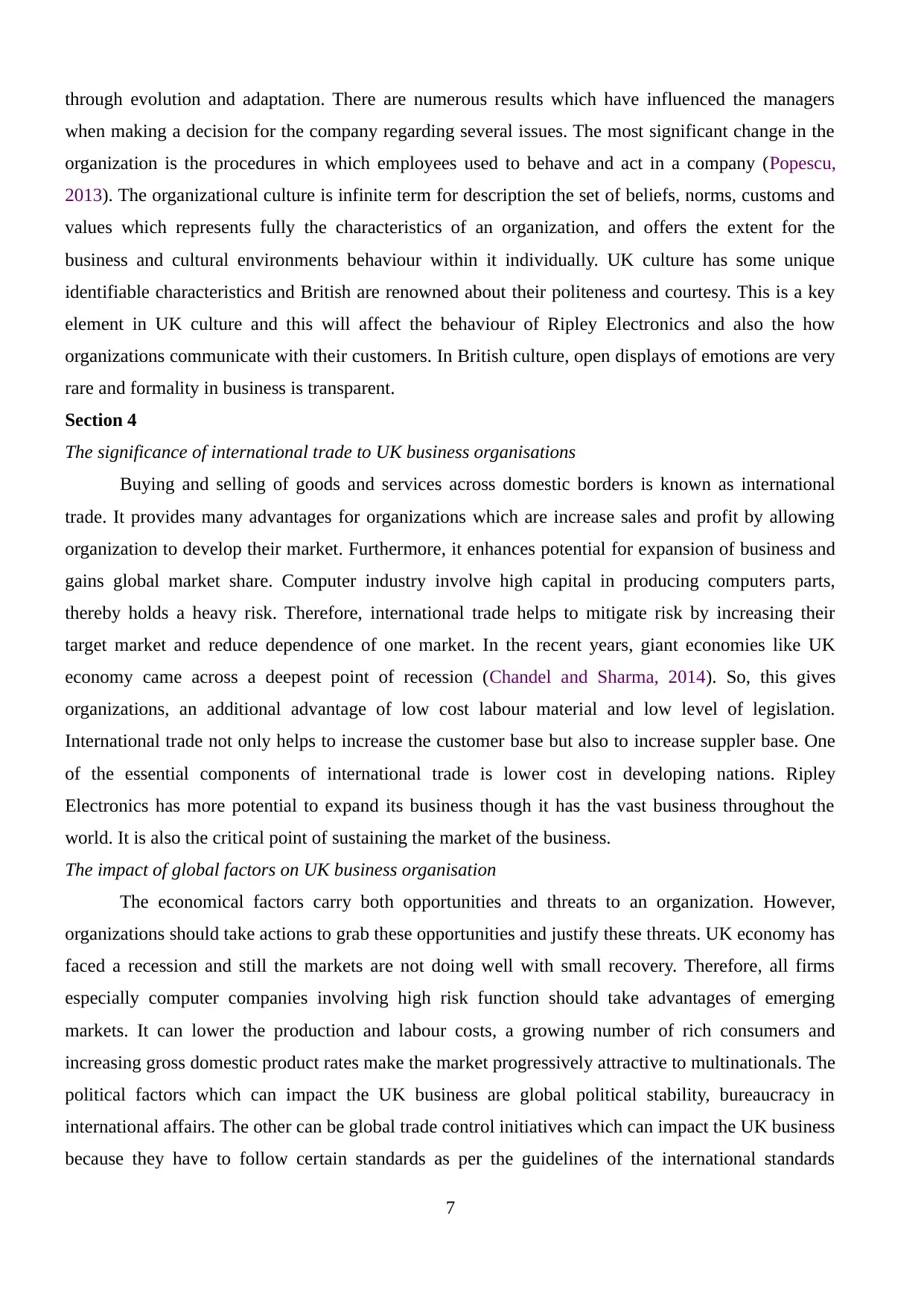
through evolution and adaptation. There are numerous results which have influenced the managers
when making a decision for the company regarding several issues. The most significant change in the
organization is the procedures in which employees used to behave and act in a company (Popescu,
2013). The organizational culture is infinite term for description the set of beliefs, norms, customs and
values which represents fully the characteristics of an organization, and offers the extent for the
business and cultural environments behaviour within it individually. UK culture has some unique
identifiable characteristics and British are renowned about their politeness and courtesy. This is a key
element in UK culture and this will affect the behaviour of Ripley Electronics and also the how
organizations communicate with their customers. In British culture, open displays of emotions are very
rare and formality in business is transparent.
Section 4
The significance of international trade to UK business organisations
Buying and selling of goods and services across domestic borders is known as international
trade. It provides many advantages for organizations which are increase sales and profit by allowing
organization to develop their market. Furthermore, it enhances potential for expansion of business and
gains global market share. Computer industry involve high capital in producing computers parts,
thereby holds a heavy risk. Therefore, international trade helps to mitigate risk by increasing their
target market and reduce dependence of one market. In the recent years, giant economies like UK
economy came across a deepest point of recession (Chandel and Sharma, 2014). So, this gives
organizations, an additional advantage of low cost labour material and low level of legislation.
International trade not only helps to increase the customer base but also to increase suppler base. One
of the essential components of international trade is lower cost in developing nations. Ripley
Electronics has more potential to expand its business though it has the vast business throughout the
world. It is also the critical point of sustaining the market of the business.
The impact of global factors on UK business organisation
The economical factors carry both opportunities and threats to an organization. However,
organizations should take actions to grab these opportunities and justify these threats. UK economy has
faced a recession and still the markets are not doing well with small recovery. Therefore, all firms
especially computer companies involving high risk function should take advantages of emerging
markets. It can lower the production and labour costs, a growing number of rich consumers and
increasing gross domestic product rates make the market progressively attractive to multinationals. The
political factors which can impact the UK business are global political stability, bureaucracy in
international affairs. The other can be global trade control initiatives which can impact the UK business
because they have to follow certain standards as per the guidelines of the international standards
7
when making a decision for the company regarding several issues. The most significant change in the
organization is the procedures in which employees used to behave and act in a company (Popescu,
2013). The organizational culture is infinite term for description the set of beliefs, norms, customs and
values which represents fully the characteristics of an organization, and offers the extent for the
business and cultural environments behaviour within it individually. UK culture has some unique
identifiable characteristics and British are renowned about their politeness and courtesy. This is a key
element in UK culture and this will affect the behaviour of Ripley Electronics and also the how
organizations communicate with their customers. In British culture, open displays of emotions are very
rare and formality in business is transparent.
Section 4
The significance of international trade to UK business organisations
Buying and selling of goods and services across domestic borders is known as international
trade. It provides many advantages for organizations which are increase sales and profit by allowing
organization to develop their market. Furthermore, it enhances potential for expansion of business and
gains global market share. Computer industry involve high capital in producing computers parts,
thereby holds a heavy risk. Therefore, international trade helps to mitigate risk by increasing their
target market and reduce dependence of one market. In the recent years, giant economies like UK
economy came across a deepest point of recession (Chandel and Sharma, 2014). So, this gives
organizations, an additional advantage of low cost labour material and low level of legislation.
International trade not only helps to increase the customer base but also to increase suppler base. One
of the essential components of international trade is lower cost in developing nations. Ripley
Electronics has more potential to expand its business though it has the vast business throughout the
world. It is also the critical point of sustaining the market of the business.
The impact of global factors on UK business organisation
The economical factors carry both opportunities and threats to an organization. However,
organizations should take actions to grab these opportunities and justify these threats. UK economy has
faced a recession and still the markets are not doing well with small recovery. Therefore, all firms
especially computer companies involving high risk function should take advantages of emerging
markets. It can lower the production and labour costs, a growing number of rich consumers and
increasing gross domestic product rates make the market progressively attractive to multinationals. The
political factors which can impact the UK business are global political stability, bureaucracy in
international affairs. The other can be global trade control initiatives which can impact the UK business
because they have to follow certain standards as per the guidelines of the international standards
7
Paraphrase This Document
Need a fresh take? Get an instant paraphrase of this document with our AI Paraphraser
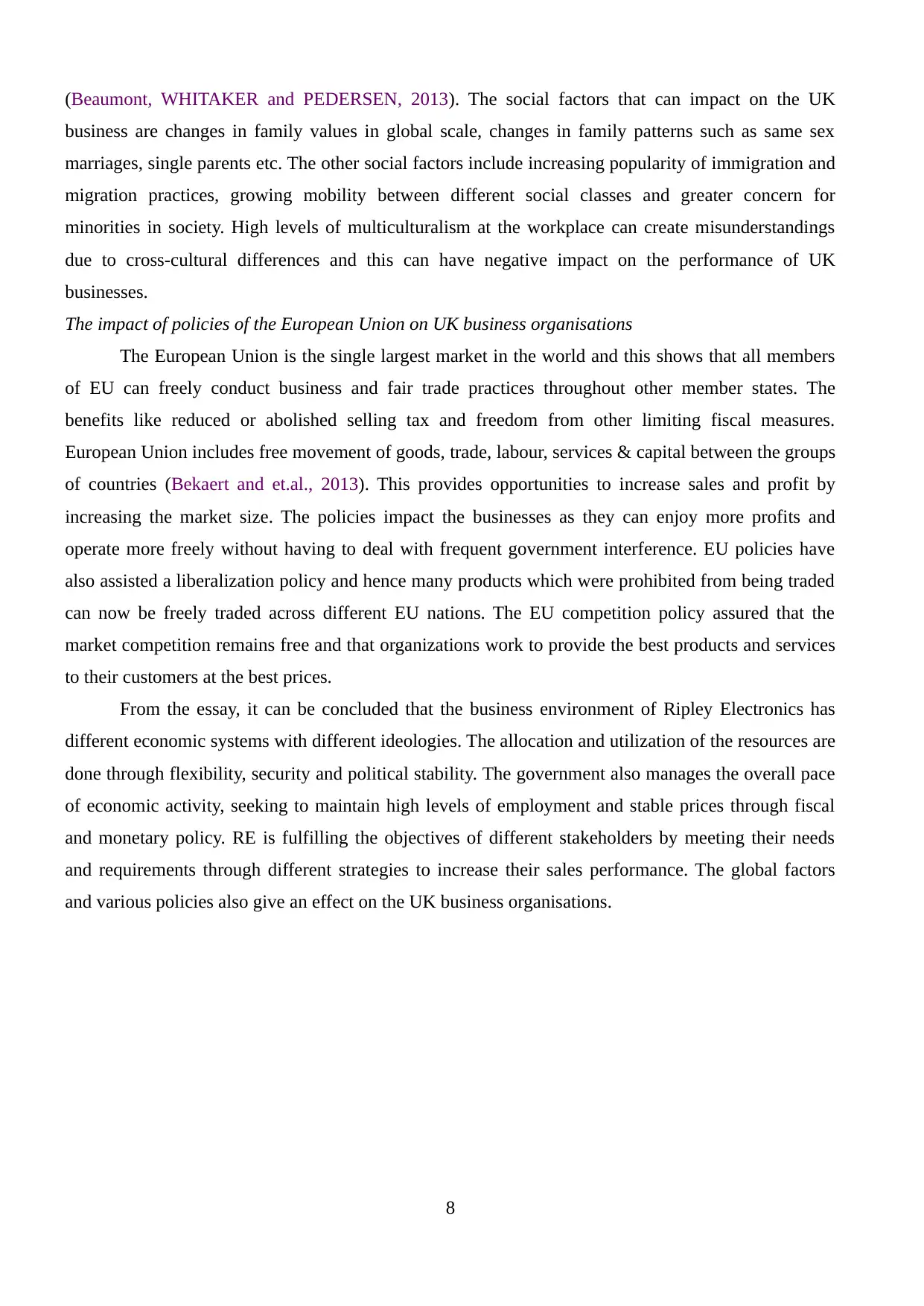
(Beaumont, WHITAKER and PEDERSEN, 2013). The social factors that can impact on the UK
business are changes in family values in global scale, changes in family patterns such as same sex
marriages, single parents etc. The other social factors include increasing popularity of immigration and
migration practices, growing mobility between different social classes and greater concern for
minorities in society. High levels of multiculturalism at the workplace can create misunderstandings
due to cross-cultural differences and this can have negative impact on the performance of UK
businesses.
The impact of policies of the European Union on UK business organisations
The European Union is the single largest market in the world and this shows that all members
of EU can freely conduct business and fair trade practices throughout other member states. The
benefits like reduced or abolished selling tax and freedom from other limiting fiscal measures.
European Union includes free movement of goods, trade, labour, services & capital between the groups
of countries (Bekaert and et.al., 2013). This provides opportunities to increase sales and profit by
increasing the market size. The policies impact the businesses as they can enjoy more profits and
operate more freely without having to deal with frequent government interference. EU policies have
also assisted a liberalization policy and hence many products which were prohibited from being traded
can now be freely traded across different EU nations. The EU competition policy assured that the
market competition remains free and that organizations work to provide the best products and services
to their customers at the best prices.
From the essay, it can be concluded that the business environment of Ripley Electronics has
different economic systems with different ideologies. The allocation and utilization of the resources are
done through flexibility, security and political stability. The government also manages the overall pace
of economic activity, seeking to maintain high levels of employment and stable prices through fiscal
and monetary policy. RE is fulfilling the objectives of different stakeholders by meeting their needs
and requirements through different strategies to increase their sales performance. The global factors
and various policies also give an effect on the UK business organisations.
8
business are changes in family values in global scale, changes in family patterns such as same sex
marriages, single parents etc. The other social factors include increasing popularity of immigration and
migration practices, growing mobility between different social classes and greater concern for
minorities in society. High levels of multiculturalism at the workplace can create misunderstandings
due to cross-cultural differences and this can have negative impact on the performance of UK
businesses.
The impact of policies of the European Union on UK business organisations
The European Union is the single largest market in the world and this shows that all members
of EU can freely conduct business and fair trade practices throughout other member states. The
benefits like reduced or abolished selling tax and freedom from other limiting fiscal measures.
European Union includes free movement of goods, trade, labour, services & capital between the groups
of countries (Bekaert and et.al., 2013). This provides opportunities to increase sales and profit by
increasing the market size. The policies impact the businesses as they can enjoy more profits and
operate more freely without having to deal with frequent government interference. EU policies have
also assisted a liberalization policy and hence many products which were prohibited from being traded
can now be freely traded across different EU nations. The EU competition policy assured that the
market competition remains free and that organizations work to provide the best products and services
to their customers at the best prices.
From the essay, it can be concluded that the business environment of Ripley Electronics has
different economic systems with different ideologies. The allocation and utilization of the resources are
done through flexibility, security and political stability. The government also manages the overall pace
of economic activity, seeking to maintain high levels of employment and stable prices through fiscal
and monetary policy. RE is fulfilling the objectives of different stakeholders by meeting their needs
and requirements through different strategies to increase their sales performance. The global factors
and various policies also give an effect on the UK business organisations.
8
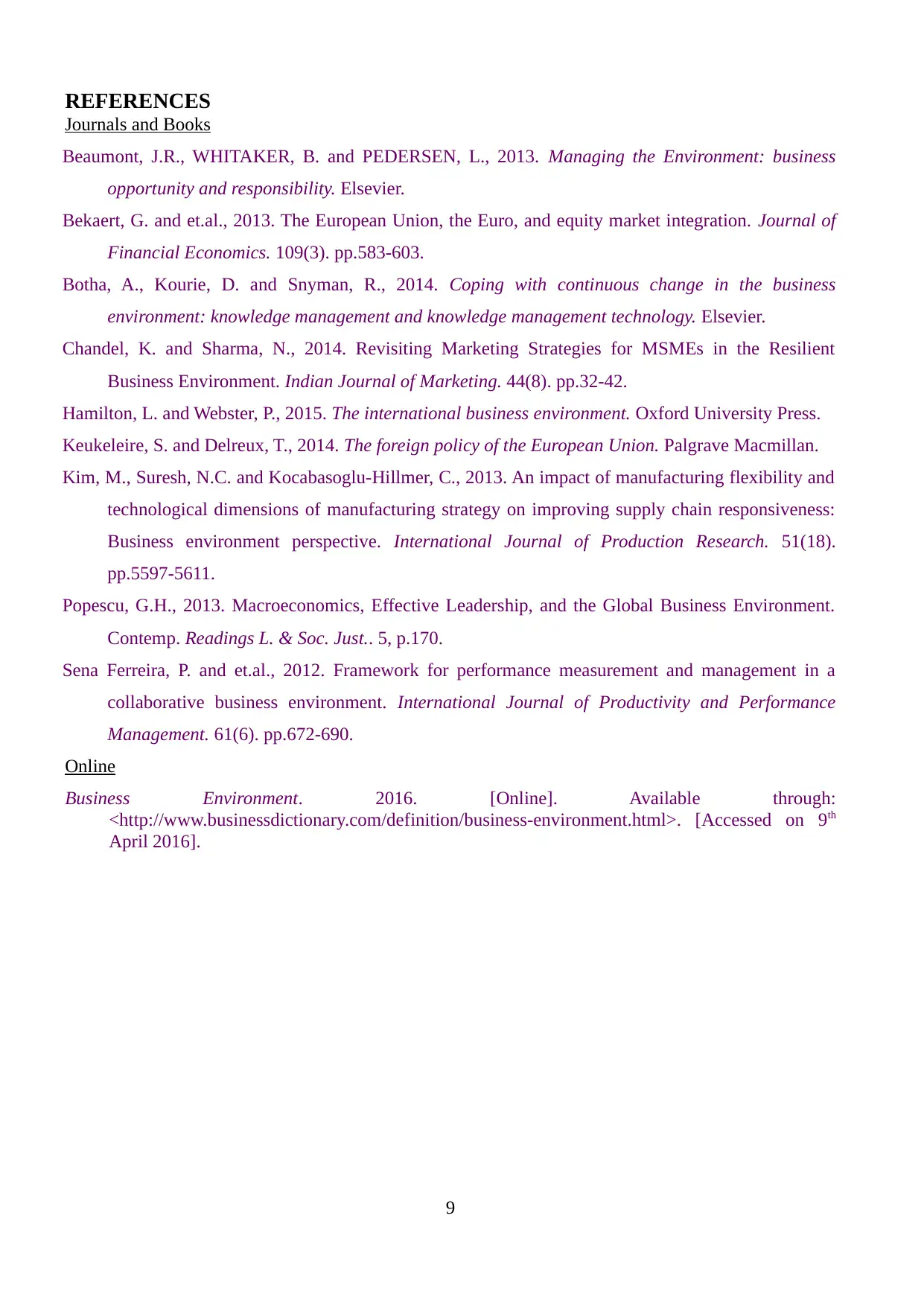
REFERENCES
Journals and Books
Beaumont, J.R., WHITAKER, B. and PEDERSEN, L., 2013. Managing the Environment: business
opportunity and responsibility. Elsevier.
Bekaert, G. and et.al., 2013. The European Union, the Euro, and equity market integration. Journal of
Financial Economics. 109(3). pp.583-603.
Botha, A., Kourie, D. and Snyman, R., 2014. Coping with continuous change in the business
environment: knowledge management and knowledge management technology. Elsevier.
Chandel, K. and Sharma, N., 2014. Revisiting Marketing Strategies for MSMEs in the Resilient
Business Environment. Indian Journal of Marketing. 44(8). pp.32-42.
Hamilton, L. and Webster, P., 2015. The international business environment. Oxford University Press.
Keukeleire, S. and Delreux, T., 2014. The foreign policy of the European Union. Palgrave Macmillan.
Kim, M., Suresh, N.C. and Kocabasoglu-Hillmer, C., 2013. An impact of manufacturing flexibility and
technological dimensions of manufacturing strategy on improving supply chain responsiveness:
Business environment perspective. International Journal of Production Research. 51(18).
pp.5597-5611.
Popescu, G.H., 2013. Macroeconomics, Effective Leadership, and the Global Business Environment.
Contemp. Readings L. & Soc. Just.. 5, p.170.
Sena Ferreira, P. and et.al., 2012. Framework for performance measurement and management in a
collaborative business environment. International Journal of Productivity and Performance
Management. 61(6). pp.672-690.
Online
Business Environment. 2016. [Online]. Available through:
<http://www.businessdictionary.com/definition/business-environment.html>. [Accessed on 9th
April 2016].
9
Journals and Books
Beaumont, J.R., WHITAKER, B. and PEDERSEN, L., 2013. Managing the Environment: business
opportunity and responsibility. Elsevier.
Bekaert, G. and et.al., 2013. The European Union, the Euro, and equity market integration. Journal of
Financial Economics. 109(3). pp.583-603.
Botha, A., Kourie, D. and Snyman, R., 2014. Coping with continuous change in the business
environment: knowledge management and knowledge management technology. Elsevier.
Chandel, K. and Sharma, N., 2014. Revisiting Marketing Strategies for MSMEs in the Resilient
Business Environment. Indian Journal of Marketing. 44(8). pp.32-42.
Hamilton, L. and Webster, P., 2015. The international business environment. Oxford University Press.
Keukeleire, S. and Delreux, T., 2014. The foreign policy of the European Union. Palgrave Macmillan.
Kim, M., Suresh, N.C. and Kocabasoglu-Hillmer, C., 2013. An impact of manufacturing flexibility and
technological dimensions of manufacturing strategy on improving supply chain responsiveness:
Business environment perspective. International Journal of Production Research. 51(18).
pp.5597-5611.
Popescu, G.H., 2013. Macroeconomics, Effective Leadership, and the Global Business Environment.
Contemp. Readings L. & Soc. Just.. 5, p.170.
Sena Ferreira, P. and et.al., 2012. Framework for performance measurement and management in a
collaborative business environment. International Journal of Productivity and Performance
Management. 61(6). pp.672-690.
Online
Business Environment. 2016. [Online]. Available through:
<http://www.businessdictionary.com/definition/business-environment.html>. [Accessed on 9th
April 2016].
9
⊘ This is a preview!⊘
Do you want full access?
Subscribe today to unlock all pages.

Trusted by 1+ million students worldwide
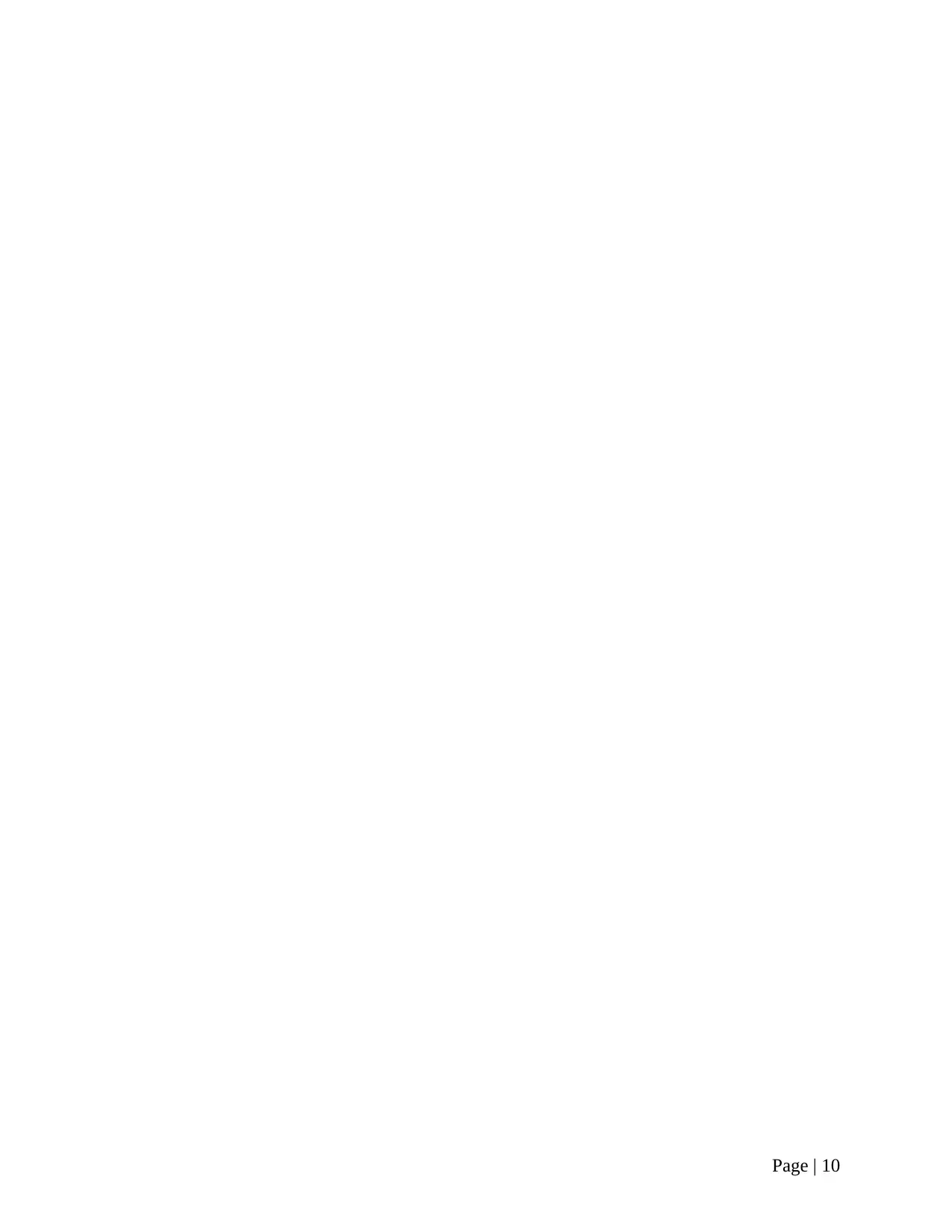
Page | 10
1 out of 10
Related Documents
Your All-in-One AI-Powered Toolkit for Academic Success.
+13062052269
info@desklib.com
Available 24*7 on WhatsApp / Email
![[object Object]](/_next/static/media/star-bottom.7253800d.svg)
Unlock your academic potential
Copyright © 2020–2025 A2Z Services. All Rights Reserved. Developed and managed by ZUCOL.





